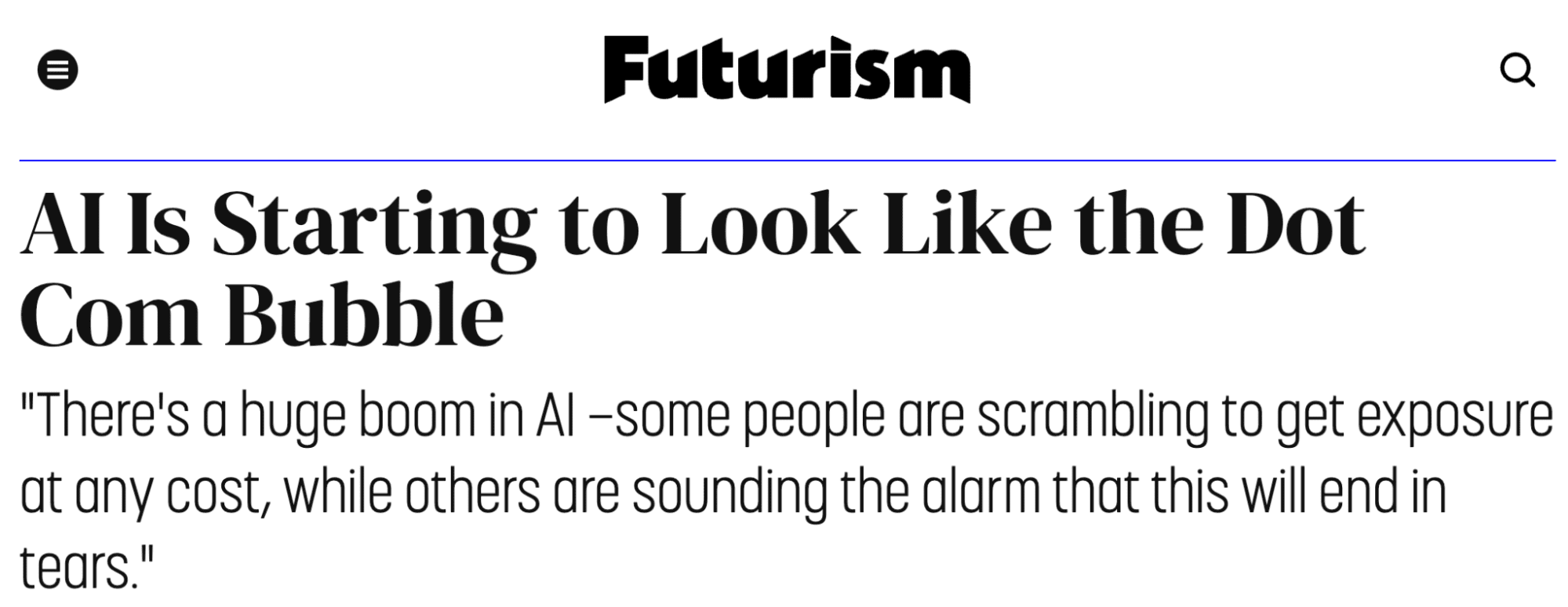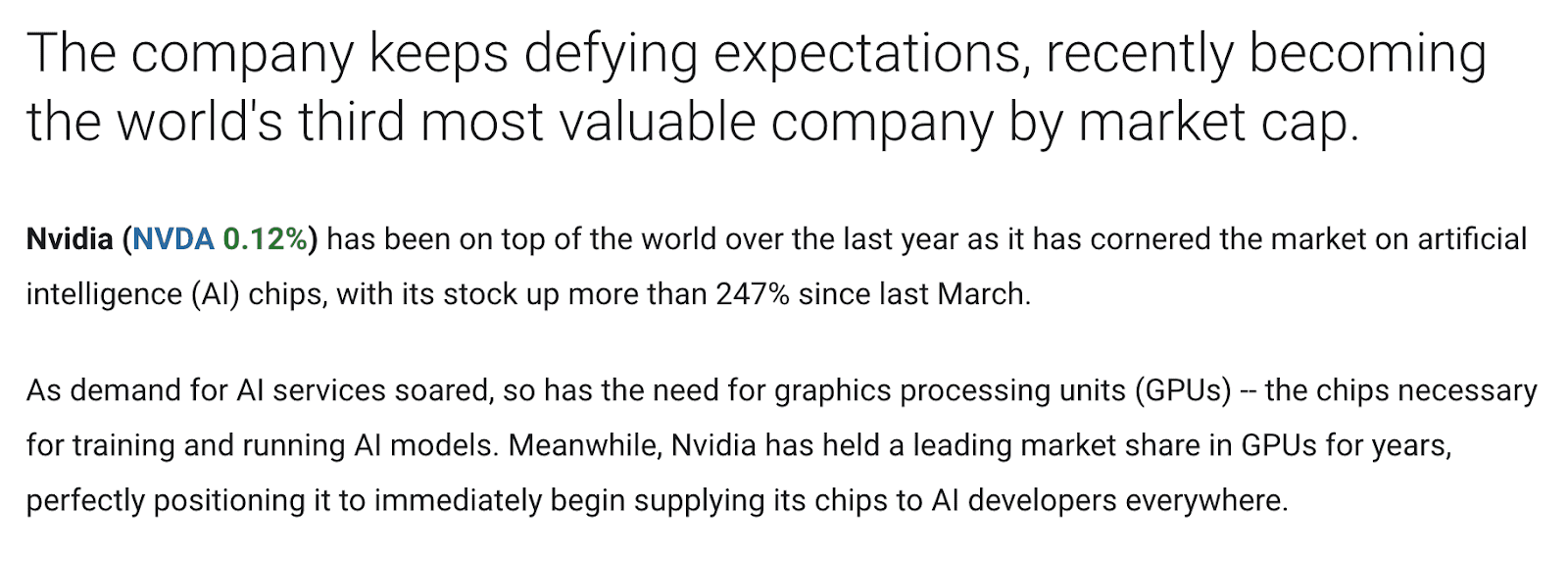
Image: Futurism
The onset of the Generative AI era has wowed everyone – the technologists and the enthusiasts alike. There are several reports and playbooks on how to ride on the Generative AI wave which is touted as the “iPhone moment” of the industry.
Interestingly, it is not just limited to the facade but has become table stakes in boardroom discussions. The executives and technologists are facing a sense of urgency to embrace this revolutionary change and accelerate their business growth.
Some consider this “wow” factor as inflated expectations from AI and fear revisiting the dot com bubble.
Let’s Talk About Nvidia First!
Amid all such frenzy, one company has recently made the headlines, i.e., Nvidia, the chip manufacturer. Notably, Nvidia is the leading GPU (Graphics Processing Units) provider, which is in high demand following the surge in the AI world. The availability of these GPUs is crucial to building AI models that require high computation power.
Nvidia stock’s stellar performance is evidence of its success trajectory, as also highlighted below:

Source: The Motley Fool
Its growth journey is a function of growing AI investments, which brings a good segue to compare today’s Dot AI (.ai) world to the Dot Com (.com which was at the start of this millennium).
The Start of the Comparison
This “.ai” vs. “.com” comparison is inspired by a series of events, one of which is the latest news of a year-old AI startup that reportedly became the fastest company to gain unicorn status in India.
A similar sentiment floated around last year when Mistral AI raised $118 million in what seems to be Europe’s largest seed fund.
Notably, the enterprises training large language models require a significant quantum of funding to make big leaps, given that the likes of OpenAI, Anthropic, and others have also raised billions of dollars in this pursuit.
Such news creates a stir in the investors’ community, especially when AI is the much sought-after industry that can get investors a premium ROI aka generational returns.
HBR also highlights this by associating the investment thesis with the industry focus rather than the idea focus – “Venture capitalists must earn a consistently superior return on investments in inherently risky businesses. The myth is that they do so by investing in good ideas and good plans. In reality, they invest in good industries — that is, industries that are more competitively forgiving than the market as a whole. And they structure their deals in a way that minimizes their risk and maximizes their returns.”
One thing is clear, the world looks binary amid ChatGPT fever — GenAI and the rest of the world.
Bubble or Not?
Now comes the big question — is it a bubble?
Consider these statistics from FortuneBusinessInsights that expect the global GenAI market to increase at a CAGR of ~40% to $967B by 2032.
With such potential, there are also reports comparing this “.ai” bubble to the “.com” bubble.
So, let’s discuss the rationale that makes the market think of AI as another impending bubble.
While AI is the sought-after industry, one needs to watch out for leading indicators of an upcoming bubble. Speculative investments, lack of the right expertise, and no clear differentiator or innovation are the early signs of an inviting bubble.
Investors, in general, watch out for a robust diligence process, including but not limited to assessing the business model, financial, and legal intricacies, market demand, and analysis, which is a critical step in evaluating the investment opportunity.
Further, the strong governance policies, relevant product-market fit, and how viable the proposal concerning the feasibility, scalability, and potential for achieving greater returns are some of the key factors driving the investor’s decisions. Additionally, the revenue-generating capability, understanding of the total addressable market, barriers to entry, the business moat, and growth strategy also indicate a green signal.
Novelty and cutting-edge offerings like that of AI are seen as a golden opportunity for substantial returns on investment.
A Lot of Investments Go Rogue, but Why?
However, choosing the right investments is a challenging task. Let’s discuss some statistics that describe these risks:
- ~75% of the firms even fail to break even the investments
- In the context of disruptive technology such as AI, the reports suggest such startups carry a higher rate of failure due to inherently associated risk
CNN also reports that “some investors and people in the industry are worried the funding frenzy is turning into a bubble, with money thrown at companies that have neither earnings nor an innovative product nor the right expertise.”
Let’s see what investors typically look at. It is a common perception among investors that the success of the enterprise largely hinges on the founders’s resilience, integrity, and ability to execute innovative ideas into reality. Some factors consider the robustness of the business concept itself and its ability to address the customers’ pain points.
In addition to these attributes, various psychological factors like confidence in the founders’ ability (which could be assessed based on whether they are first-time founders or had successful exist in the past), or the founder's receptiveness to include contrarian views also provide an additional set of indicators (albeit non-quantitative) to onboard.
However, human experts, investors in this case, can only consider limited factors at a time to make the most effective decision. That’s where the power of computing aka machines comes into the picture, helping investors make data-backed decisions.
Then vs. Now of the VC World
Due to the inherently high-risk, high-impact nature of the venture capital industry, AI could be used to augment the VC’s hunch, something that is based more on quantitative analysis coming from historical data points. These models assess the viability of the proposal and predict the likelihood of success of an investment
Welcome to modern data-driven investing.
Quoting Gartner:
“The traditional pitch experience will significantly shift by 2025 and tech CEOs will need to face investors with AI-enabled models and simulations as traditional pitch decks and financials will be insufficient”
Building AI tools for evaluating attractive AI opportunities seems like an effective use of technology among multiple attractive uses of AI. It is a fair expectation that the investment community will benefit from such quantified tools that make informed investment decisions, saving the industry from another bubble.
Vidhi Chugh is an AI strategist and a digital transformation leader working at the intersection of product, sciences, and engineering to build scalable machine learning systems. She is an award-winning innovation leader, an author, and an international speaker. She is on a mission to democratize machine learning and break the jargon for everyone to be a part of this transformation.
